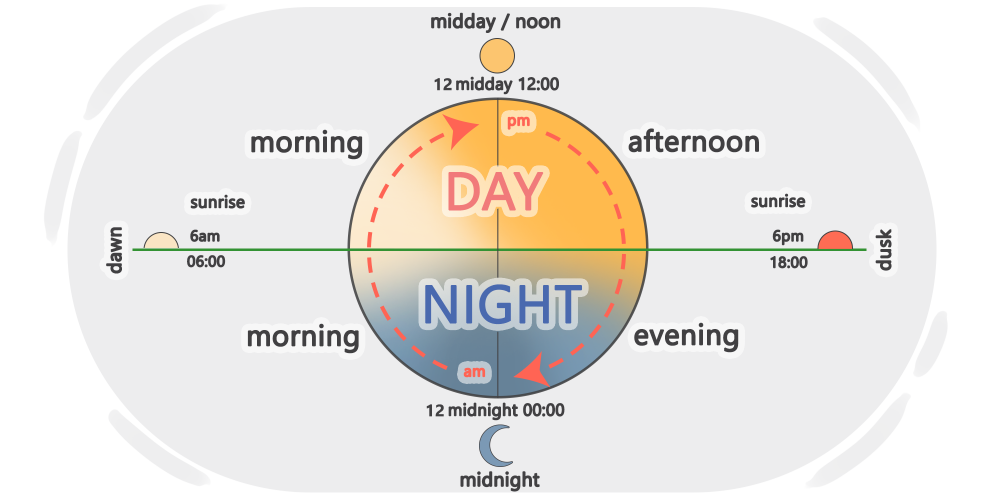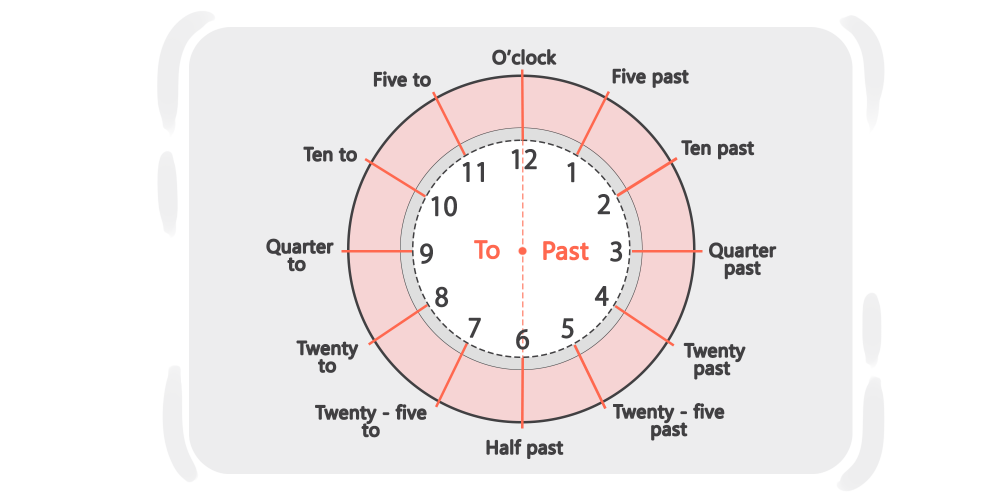Expressing Time

How to Express Time?
Expressing time involves representing a specific point in time using numerical values. Time is typically expressed in hours, minutes, and seconds and can be represented in 12-hour or 24-hour format.
Parts of the Day
On this list, you can see different parts of the day with their approximate time:
Morning 12:01 am.- 11:59 am.
Noon 12:00 pm.
Afternoon 12:01 pm. - 5:00 pm.
Evening 5:01 pm. - 9:00 pm.
Night 9:01 pm. - 11:59 pm.
Midnight 12:00 am.
Remember, time is inexact and it can change based on the geographical area.


Different Ways to Tell the Time
One way to read the time is to tell it in a digital way. Another way is to use the analogue way.
Digital Time
A digital clock only shows the numbers and it has no hands. When reading these clocks, you just read the numbers you see one by one. Look at the examples for more information.
02:45 = It is two forty-five.
09:30 = It is nine thirty.
When you are reading a digital clock, you have to read the hour as a separate number and the minutes as another number. Remember, when the minutes are less than ten you should use 'oh' to stand for zero in the clock and if there are two zeros in the minute section, you have to read it as o'clock. For example:
02:02 = It is two oh two.
07:12 = It is seven twelve.
Analogue Time
An analogue (also analog) clock has three hands, one shows the hour, another shows the minute, and the other shows seconds.
To and Past
When the minute hand is pointing at a number before six, you have to use the word past to tell the minute; but when the minute hand points to a number after six, you use the word 'to'. Here are some examples:
04:12 → It is twelve past four.
08:45 → It is fifteen to nine.
Using the Word 'Minute'
When you are telling the time, you usually do not use the word 'minute', but you can also use it to be clear. For example:
03:16 → It is sixteen minutes past three.
07:40 → It is twenty minutes to eight.
Using O'clock
When there are no minutes, you can express the time by either not reading it or using o'clock. Here are a few examples:
11:00 → It is eleven o'clock.
06:00 → It is six o'clock.
What Is a Quarter in Time?
Every fifteen minutes in time is called a quarter, so when there are fifteen minutes in time we can also use a quarter. Take a look at the examples:
06:45 → It is fifteen to seven./ It is a quarter to seven.
07:15 → It is fifteen past seven./ It is a quarter past seven.
What Is Half in Time?
Every thirty minutes in time equals a half. As a result, we can use it instead of thirty minutes. Look at the examples:
11:30 → It is eleven thirty./ It is half past eleven.
10:30 → It is half past ten.
Past or To?
When the minute hand is on six, we do not use the word to, instead, we use the word past to tell the time. Check out the examples:
09:30 → It is half past nine.
10:30 → It is half past ten.
How To Tell Time on An Analogue Clock?
The figure below shows how you can tell the time on an Analogue clock:


Asking The Time
There are many ways to ask about the time, and regardless of who you are asking or the context of the situation, it is important to maintain a polite tone. Here are some common ways to ask the time.
What Time Is It?
This is the most common question for asking the time. This is an informal way to ask the time. There are some more similar expressions for informal contexts:
What is the time?
What's the time by your watch?
Do you know the time?
What time is it now?
Could You Please Tell Me The Time?
Using "could you" and "please" is a more formal and polite way of asking the time. If you want to sound even more polite, you can use the following examples:
Would you tell me what time is it now?(please)
Would you mind if i ask you the time?
very polite
What Time...
There are other structures to ask about specific times. Let's check some examples:
What time does the show start?
What time should we get there?
We can also replace 'what time' with 'when' to ask these questions.
When does the show start?
When should we get there?
Tip!
Do not confuse 'asking for time' with 'asking the time'. If you are asking the time, you simply want to know what the time is or how long something will take or what time something happens, but if you are asking for time, it means you are requesting someone to give you some of their time or asking when they have free time.
How to Tell the Time
If someone asks you what time it is, you can answer them using 'It Is' or 'It’s'.
What time is it now? It's 5 o'clock.
Would you mind telling me what time it is, please? It is half past ten.
If someone asks you about a specific time, you can answer them using 'at + the time'
What time does the show start? It starts at 5:45.
What time should we get there? We should get there at noon.
If you don't know the time or you do not have a watch on you, you can use the following phrases.
Sorry, I don't have a watch on me.
Sorry, I don't know the time.
Prepositions For Telling The Time
There are three prepositions that we can use to express time.
At
We usually use 'at' to point to a specific time.
At 12:00.
At night.
At dinner time.
At the moment.
On
We can use 'on' to refer to days or dates.
On monday.
On 31 October.
On Christmas day.
On my birthday.
In
We can use 'in' to refer to longer periods, such as months, years, etc.
In November.
In winter.
In 2022.
In the future.
AM and PM
A day has 24 hours. Using a 12-hour clock system can make it a bit confusing for us to tell the time. That is why we use AM and PM to clarify. Let’s see what they stand for:
AM is an abbreviation form of the Latin Ante meridiem meaning before noon, and PM is an abbreviation form of the Latin post meridiem meaning after noon. Therefore, we use AM for the time after midnight (12:00 midnight) until midday (12:00 midday), and we use PM for after midday (12:00 midday) until midnight (12:00 midnight). Let's see some examples:
It's 4:00 AM.
It's 4 after midnight, very early in the morning.
It's 4:00 PM.
It's 4 after midday, almost in the evening.
In British English, these abbreviations are usually written as a.m. and p.m., in lowercase and with full stops. In American English, they are written in uppercase letters and without full stops (AM/PM). They are both correct and you can use them depending on the variety of English you are using.
Military Time
Military time is a 24 hours system of measuring time; it is also referred to as '24-hour clock'. Most Americans do not use this system. Military time always has four digits starting at 0000 (zero hundred) and finishing at 2359 (twenty-three fifty-nine). From 0000 to 1159 corresponds to AM time, and from 1200 to 2359 corresponds to PM time. Here are some examples:
0300 (zero, three-hundred)
It corresponds to 3 AM.
0230 (zero, two - thirty)
It corresponds to 2:30 AM.
1500 (fifteen hundred)
It corresponds to 3 PM.
1430 (fourteen thirty)
It corresponds to 2:30 PM.
Punctuation
When we write the time in its numerical form, we can use different punctuation to separate the hours, minutes, and seconds. We can use colons, periods, and in the military case, no punctuation at all.
8:35:13 PM
8.35.13 PM
2035
no punctuation, military style
Comments
(0)